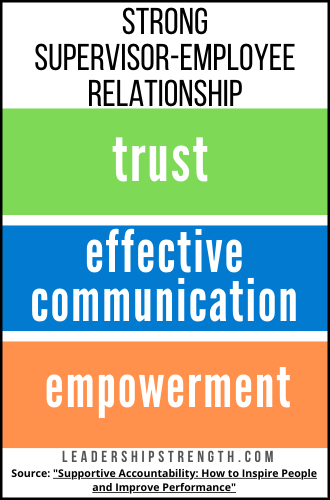Times are hard.
People are stressed.
Yet, as a leader, you’re feeling the pressure of achieving performance goals.
But don’t worry. You can help your team get through the storm without sacrificing performance. In fact, when you manage performance the right way, you can significantly boost quality and productivity.
The key is in embracing the heart of supportive performance management.
Support Unleashes Performance
When you intentionally identify and meet employees’ support needs, you are in a much better position to unleash employee potential and achieve results.
In Supportive Accountability Leadership™, support is anything the employee reasonably needs to achieve strong job performance. Employees can’t succeed and sustain success over time without adequate support. Support fosters a work environment where people can thrive.
A Supportive Direct Supervisor is Critical
As a supervisor, you’re the most critical source of support for employees.
You’re the “face” of the organization. Everything you do and say represents the organization in the eyes of employees.1 How you interact with people shapes their perception of leadership, supportiveness, and fairness, and this perception affects employee trust and performance.
Research has consistently shown that the supervisor-employee relationship influences:
- Employee perception of support,
- Engagement,
- Commitment to the organization,
- Turnover intentions,
- Ethical behavior, and
- Performance.2
You—more than any other workplace factor—sways employees’ decision to stay with or leave your organization.3 So, how much you support employees directly affects retention.
Many Employees Don’t Feel Supported

The sad truth is that many employees don’t feel empowered or supported in their workplaces.
Surveys of employees in the U.S. have consistently shown that most view their supervisor as the greatest source of workplace stress.4 To make matters worse, supervisors are a chief contributor to employee burnout.5
But it doesn’t have to be this way.
Supportive Performance Management is a Skill
Supportive performance management can be learned.
It’s not some mystical talent that people either have or don’t have. And while some leaders are naturally more people-focused than others, those of us that tend to focus on performance can train our hearts and brains to put people first.
I know because I’ve been there.
I’m naturally wired to skip the niceties and get straight to performance. But this doesn’t work.
When people don’t feel valued, it’s hard for them to get their heads in the game. What’s more, the way you approach employee performance management can either increase or reduce employee stress and burnout.
So, what can you do?
Build and maintain strong supervisor-employee relationships.
Three Pillars of a Strong Supervisor-Employee Relationship
The three pillars of a strong supervisor-employee relationship are trust, effective communication, and empowerment. When you consistently live by these three pillars, you establish mutually rewarding and professional relationships with the people on your team. And this sparks performance.
The First Pillar: Trust
Employees trust you as a leader when they believe your intentions towards them are good, and they feel safe being vulnerable with you.6
The way you interact with the people you serve directly impacts how much they trust you and your organization. Employees trust leaders who care about them, demonstrate honesty, create a safe environment, act in fairness and consistency, and keep their promises.
The research shows that trust fosters:
- Strong teamwork,
- Cooperation,
- Information sharing,
- Problem-solving,
- Conflict resolution,
- Innovation,
- Productivity, and
- Performance.7
The Second Pillar: Effective Communication
Effective communication creates a cooperative working relationship where you and the employee exchange information, resources, and support.
Effective communication is frequent, high-quality, two-way, collaborative, and individualized. But this type of communication is easier said than done. Differences in preferences, culture, and other factors get in the way of our having successful conversations.
The most successful leaders know this and intentionally work on developing their leadership communication skills. They know that leadership is a journey and embrace lifelong learning.

Take Your First Step in Boosting Your Leadership Communication
Get Your Free Copy of “The Quick Guide to DISC Leadership Styles.”
The Third Pillar: Empowerment
Empowerment is the process by which leaders give employees the power and authority to make decisions at their level, recognize and solve problems,8 and go above and beyond expectations. It’s the opposite of micromanagement.
True empowerment creates a safe environment for employees to look beyond the status quo and respectfully challenge their leadership’s thinking. Leaders who are secure welcome and even crave this type of healthy debate. They know it encourages diverse perspectives and sparks innovation, leading to more efficient ways of doing business.
Empowerment gives employees the freedom, trust, and self-confidence to identify their own support needs and share these needs with their managers and supervisors.
Employees can’t succeed and sustain success without adequate support. A strong supervisor-employee relationship is the most important source of support you can provide the people you lead.
How well you can identify and meet people’s support needs will hinge on the quality of the relationships you build.
SYLVIA MELENA is the Founder and CEO of Melena Consulting Group, a leadership and management consulting and training company. She is also the award-winning author of Supportive Accountability: How to Inspire People and Improve Performance.
REFERENCES: Adapted from partial excerpts taken from: Melena, Sylvia.Supportive Accountability How to Inspire Peopleand Improve Performance. La Mesa, CA: Melena Consulting Group, 2018, pp. 16 - 28. Reprinted with permission. 1Florence Stinglhamber et al., “Employees’ Organizational Identification and Affective Organizational Commitment: An Integrative Approach,” PLoS ONE 10, no. 4 (2015): 1–23. https://doi.org/10.1371/journal.pone.0123955. Creative Commons License: https://creativecommons.org/licenses/by/4.0/. Date Accessed: 12/23/20 2 Ishfaq Ahmed et al., “A Literary Look at Outcomes of Support at Work,” Research Journal of Applied Sciences, Engineering and Technology 5, no. 12 (2013): 3444–3449, http://maxwellsci.com/print/rjaset/v5-3444-3449.pdf. Creative Commons License: https://creativecommons.org/licenses/by/3.0/. Date Accessed: 12/23/20. 3 Florence Stinglhamber et al., “Employees’ Organizational Identification,” 1–23. 4J.D. Tony Carter, “Managers Empowering Employees,” American Journal of Economics and Business Administration 1, no. 2 (2009): 41–46, https://www.thescipub.com/abstract/10.3844/ajebasp.2009.41.46. Creative Commons License: https://creativecommons.org/licenses/by/4.0/. Date Accessed: 12/23/20. 5Cody Logan Chullen, “How Does Supervisor Burnout Affect Leader-Member Exchange? A Dyadic Perspective,” International Business & Economics Research Journal 13, no. 5 (2014): 1113–1126, https://doi.org/10.19030/iber.v13i5.8777. Creative Commons License: https://creativecommons.org/licenses/by/3.0/. Date Accessed: 12/23/20. 6, 7Janine Victor and Crystal C. Hoole. “The Influence of Organisational Rewards on Workplace Trust and Work Engagement,” SA Journal of Human Resource Management 1, no. 0, (2017): 1–14, https://sajhrm.co.za/index.php/sajhrm/article/view/853. Creative Commons License: https://creativecommons.org/licenses/by/4.0/. Date Accessed: 12/23/20. 8Tajammal Hussain and Sheikh Sana ur Rehman, “Do Human Resource Management Practices Inspire Employees’ Retention?, ” Research Journal of Applied Sciences, Engineering and Technology 6, no. 19 (2013): 3625–3633, http://dx.doi.org/10.19026/rjaset.6.3569, Creative Commons License: https://creativecommons.org/licenses/by/3.0/.Date Accessed: 12/23/20.













